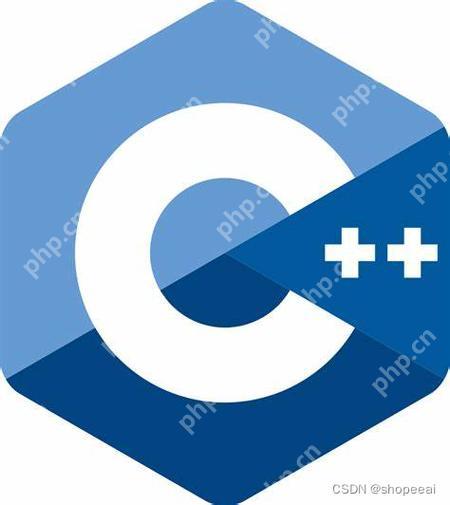在c++++中实现栈可以使用数组或链表。1)数组实现的栈访问速度快,但有固定大小限制。2)链表实现的栈可以动态调整大小,但访问速度较慢。

在编程世界里,数据结构就像是建筑中的砖块,构建出各种复杂的应用。今天我们要聊聊C++中的栈(stack)——一种后进先出(LIFO)的数据结构。为什么要关注栈呢?因为它在内存管理、函数调用、表达式求值等方面都扮演着关键角色。通过这篇文章,你将学会如何在C++中实现一个栈,并掌握一些实践中的小技巧和注意事项。
在开始深入探讨栈之前,让我们先回顾一下C++中的一些基础概念。C++是一种强大的编程语言,支持面向对象编程和泛型编程。栈在C++中通常用于存储临时数据,比如函数调用时的局部变量。理解C++中的内存管理和数据结构是实现栈的基础。
栈是一种线性数据结构,它遵循后进先出的原则(LIFO)。你可以想象它像一摞盘子,每次只能从顶部添加或移除盘子。栈在C++中有多个应用场景,比如函数调用栈、表达式求值、撤销操作等。它的主要操作包括:
立即学习“C++免费学习笔记(深入)”;
push:将元素压入栈顶pop:从栈顶移除元素top:查看栈顶元素但不移除empty:检查栈是否为空size:获取栈中元素的数量让我们看一个简单的示例:
#include <iostream>
#include <stack>
int main() {
std::stack<int> s;
s.push(1);
s.push(2);
s.push(3);
while (!s.empty()) {
std::cout << s.top() << " ";
s.pop();
}
return 0;
}这段代码创建了一个整数栈,并依次压入3、2、1,然后将它们弹出并打印出来,输出结果将是3 2 1。
实现一个栈,我们可以使用数组或链表。数组实现的栈访问速度快,但有固定大小限制;链表实现的栈可以动态调整大小,但访问速度较慢。让我们深入探讨一下数组实现的栈:
class Stack {
private:
int arr[100]; // 假设最大容量为100
int top;
public:
Stack() : top(-1) {}
void push(int x) {
if (top >= 99) {
throw std::overflow_error("Stack Overflow");
}
arr[++top] = x;
}
void pop() {
if (top < 0) {
throw std::underflow_error("Stack Underflow");
}
top--;
}
int peek() {
if (top < 0) {
throw std::underflow_error("Stack is empty");
}
return arr[top];
}
bool isEmpty() {
return top < 0;
}
};这个实现中,top变量用于跟踪栈顶的位置。push操作增加top并将新元素放入数组中,pop操作减少top来移除顶部元素。peek操作返回顶部元素而不移除它。
让我们看一个简单的例子,展示如何使用我们实现的栈:
#include <iostream>
int main() {
Stack s;
s.push(1);
s.push(2);
s.push(3);
std::cout << s.peek() << std::endl; // 输出3
s.pop();
std::cout << s.peek() << std::endl; // 输出2
s.pop();
std::cout << s.peek() << std::endl; // 输出1
s.pop();
if (s.isEmpty()) {
std::cout << "Stack is empty" << std::endl;
}
return 0;
}这段代码展示了如何使用push、pop、peek和isEmpty操作来管理栈。
在实际应用中,栈可以用于实现更复杂的算法,比如中缀表达式转后缀表达式:
#include <iostream>
#include <string>
#include <stack>
std::string infixToPostfix(std::string infix) {
std::stack<char> s;
std::string postfix = "";
for (char c : infix) {
if (isalnum(c)) {
postfix += c;
} else if (c == '(') {
s.push(c);
} else if (c == ')') {
while (!s.empty() && s.top() != '(') {
postfix += s.top();
s.pop();
}
s.pop(); // 移除 '('
} else {
while (!s.empty() && precedence(s.top()) >= precedence(c)) {
postfix += s.top();
s.pop();
}
s.push(c);
}
}
while (!s.empty()) {
postfix += s.top();
s.pop();
}
return postfix;
}
int precedence(char op) {
if (op == '+' || op == '-') return 1;
if (op == '*' || op == '/') return 2;
return 0;
}
int main() {
std::string infix = "A+B*C-D/E";
std::string postfix = infixToPostfix(infix);
std::cout << postfix << std::endl; // 输出: ABC*+DE/-
return 0;
}这个例子展示了如何使用栈来转换中缀表达式为后缀表达式,这在编译器设计和计算器实现中非常有用。
实现栈时,常见的错误包括:
调试这些问题的方法包括:
在实际应用中,优化栈的性能和遵循最佳实践非常重要:
template <typename T>
class Stack {
private:
std::vector<T> arr;
public:
void push(T x) { arr.push_back(x); }
void pop() { if (!arr.empty()) arr.pop_back(); }
T peek() { if (!arr.empty()) return arr.back(); throw std::underflow_error("Stack is empty"); }
bool isEmpty() { return arr.empty(); }
size_t size() { return arr.size(); }
};这个实现使用了std::vector来动态管理栈的大小,提供了更大的灵活性。
在实践中,理解栈的实现原理和应用场景可以帮助你更好地设计和优化代码。希望这篇文章能为你提供有用的见解和实用的代码示例,助你在C++编程之路上更进一步。
以上就是c++++栈(stack)怎么实现的详细内容,更多请关注php中文网其它相关文章!

c++怎么学习?c++怎么入门?c++在哪学?c++怎么学才快?不用担心,这里为大家提供了c++速学教程(入门到精通),有需要的小伙伴保存下载就能学习啦!

Copyright 2014-2025 https://www.php.cn/ All Rights Reserved | php.cn | 湘ICP备2023035733号